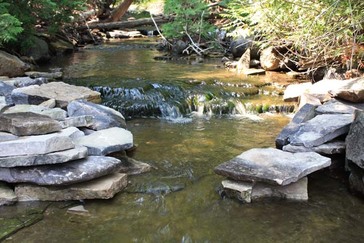Mill Creek

Rehabilitation and Enhancement Project
This approximate 400m long coldwater spring fed creek had several issues affecting it. The middle 2/3 of the creek was once backed up by beaver activity, which created a marsh that drowned all of the riparian and canopy vegetation. The beaver activity is no longer an issue, however the resulting beaver meadow needed to have riparian and canopy trees/shrubs planted to rehabilitate this area. Another issue affecting the creek was lack of spawning gravel and rounded rocks to provide invertebrate habitat in most areas. For the most part, the creek bed was covered in medium/large flat stones. Some areas of the stream had seen a previous owner use heavy equipment to remove beaver dams and lodges, which scraped some parts the creek bed clear of suitable spawning and invertebrate habitat. Finally, a steep incline, with large rock shelves at the mouth up to 100m of the start of the creek created migration difficulties.
The resulting rehabilitation effort saw trees and shrubs planted in the riparian and canopy zones. Spawning gravel was added to the creek bed in several key locations near the mid and upper reaches. Large flat rock was used to reinforce the banks in the beaver meadow area to prevent erosion and to create a more defined channel. Woody material and rounded cobble stone type in-stream habitat was added and weeping weirs and wing deflectors were created to increase velocity and depth to allow for easier migration, oxygenation and the scouring and removal of silt from the creek bed.
The rehabilitation of Mill Creek in Meldrum Bay, ON involved the installation of the following fish habitat features:
This project had 4 OMNR Manitoulin Area Stewardship Rangers and 1 leader who put in 120 hours worth of work. This project also had 21 OMNR Stewardship Rangers from Killarney Provincial Park and 3 leaders who put in 192 hours worth of work.
The 5 Dawson’s Citizens Improvement Association members and 3 Gore Bay Fish and Game Club members put in 178 hours worth of preparation work, gathering materials and labour.
In-kind support from the community included deliver spawning gravel, donation of use of a large excavator, donation of use of a mini excavator and the use of 3 ATV’s to move materials during the rehabilitation phase.
This project had 7 volunteers from the Board of Directors of Manitoulin Streams participate in planning and actively volunteering at rehabilitation sites. The total number of hours volunteered for this site is 51.4 hours.
The landowner contributed approximately 8 hours of volunteer time and use of facilities at the Mill Creek site. Funding contributions toward the construction of the project include CFWIP, COA, and NOHFC .
This approximate 400m long coldwater spring fed creek had several issues affecting it. The middle 2/3 of the creek was once backed up by beaver activity, which created a marsh that drowned all of the riparian and canopy vegetation. The beaver activity is no longer an issue, however the resulting beaver meadow needed to have riparian and canopy trees/shrubs planted to rehabilitate this area. Another issue affecting the creek was lack of spawning gravel and rounded rocks to provide invertebrate habitat in most areas. For the most part, the creek bed was covered in medium/large flat stones. Some areas of the stream had seen a previous owner use heavy equipment to remove beaver dams and lodges, which scraped some parts the creek bed clear of suitable spawning and invertebrate habitat. Finally, a steep incline, with large rock shelves at the mouth up to 100m of the start of the creek created migration difficulties.
The resulting rehabilitation effort saw trees and shrubs planted in the riparian and canopy zones. Spawning gravel was added to the creek bed in several key locations near the mid and upper reaches. Large flat rock was used to reinforce the banks in the beaver meadow area to prevent erosion and to create a more defined channel. Woody material and rounded cobble stone type in-stream habitat was added and weeping weirs and wing deflectors were created to increase velocity and depth to allow for easier migration, oxygenation and the scouring and removal of silt from the creek bed.
The rehabilitation of Mill Creek in Meldrum Bay, ON involved the installation of the following fish habitat features:
- A total length of 400 linear meters of river rehabilitated
- A total of 800 m2 of in stream habitat rehabilitated.
- Approximate 10 m buffer of riparian area along both sides of a 160 m section of marshy area created which accounts for 3,200 m2 of riparian and canopy area.
- 3 pools excavated 6m x 2m x 0.3 m deep. River bed deepened to accommodate erosion and low water levels.
- 8 weeping weirs installed to create pools and scouring downstream.
- 3 wing deflectors installed
- Shoreline reinforced with dinner plate sized limestone rocks.
- 4 cubic meters of spawning gravel spread throughout the upper half of the creek.
- 350 – 0.30 m high, white ash and high bush cranberry trees planted.
- 2 half ton loads of 5 to 10 inch rounded cobble stone installed randomly in creek bed for invertebrate habitat.
- 20 pieces of woody material installed.
This project had 4 OMNR Manitoulin Area Stewardship Rangers and 1 leader who put in 120 hours worth of work. This project also had 21 OMNR Stewardship Rangers from Killarney Provincial Park and 3 leaders who put in 192 hours worth of work.
The 5 Dawson’s Citizens Improvement Association members and 3 Gore Bay Fish and Game Club members put in 178 hours worth of preparation work, gathering materials and labour.
In-kind support from the community included deliver spawning gravel, donation of use of a large excavator, donation of use of a mini excavator and the use of 3 ATV’s to move materials during the rehabilitation phase.
This project had 7 volunteers from the Board of Directors of Manitoulin Streams participate in planning and actively volunteering at rehabilitation sites. The total number of hours volunteered for this site is 51.4 hours.
The landowner contributed approximately 8 hours of volunteer time and use of facilities at the Mill Creek site. Funding contributions toward the construction of the project include CFWIP, COA, and NOHFC .






